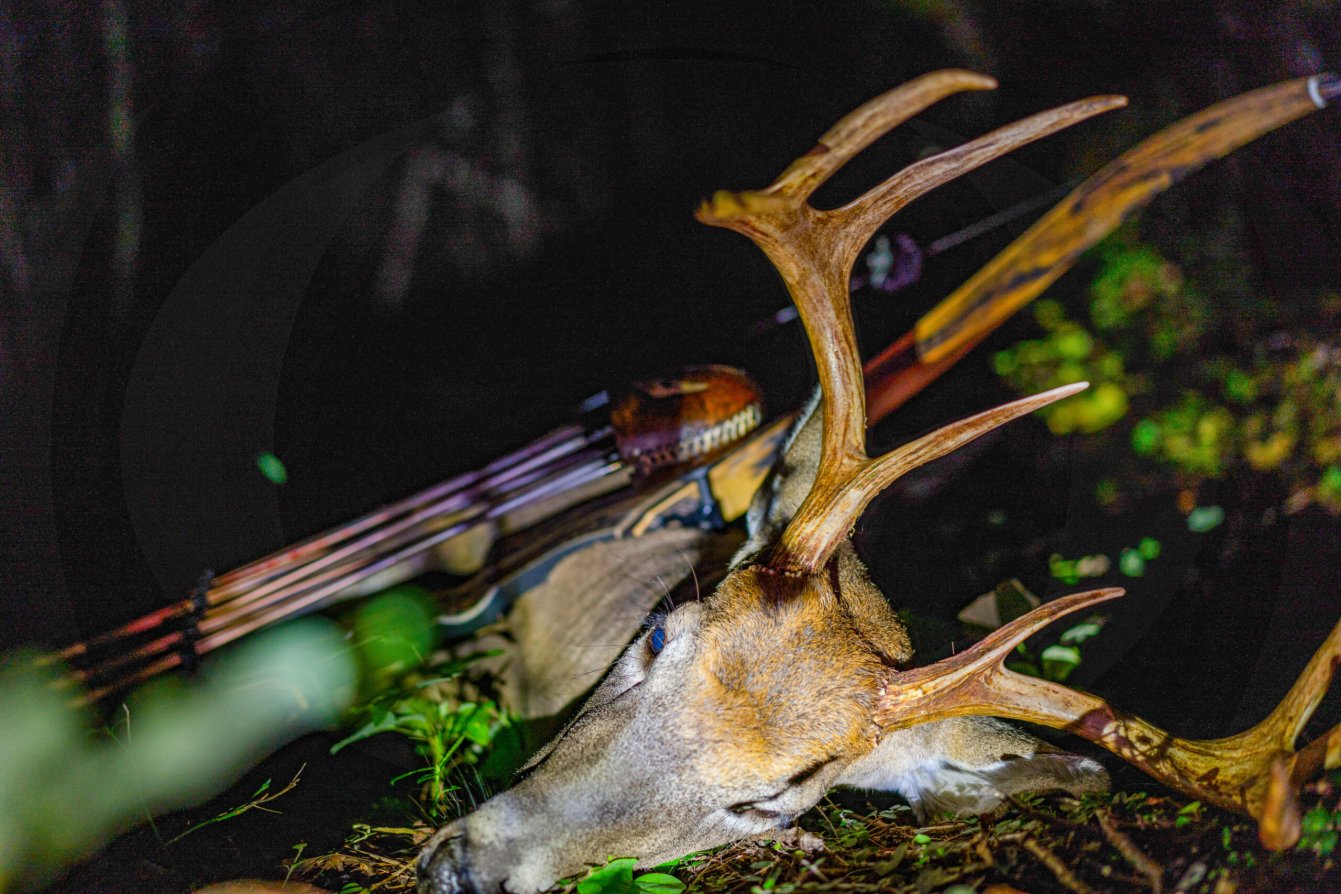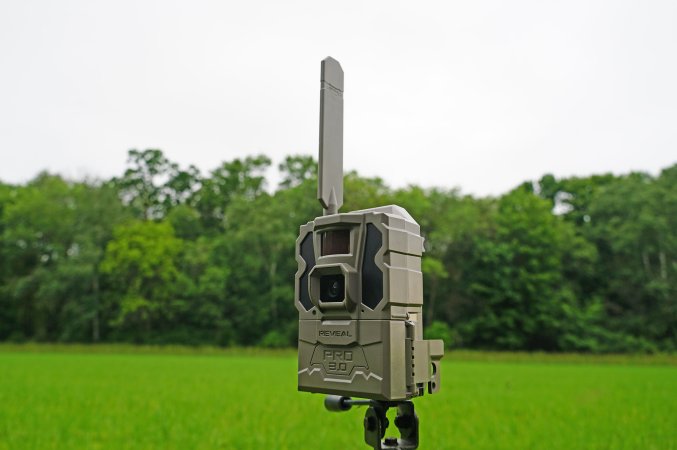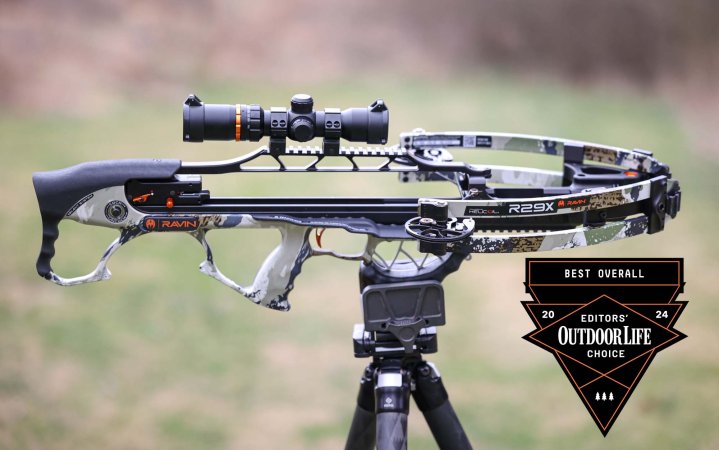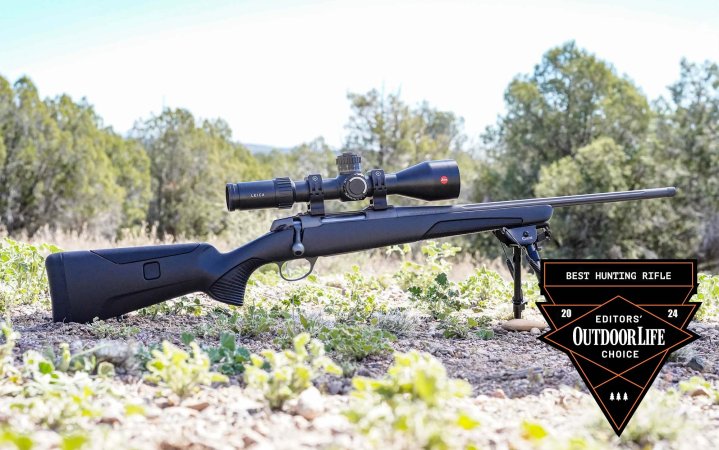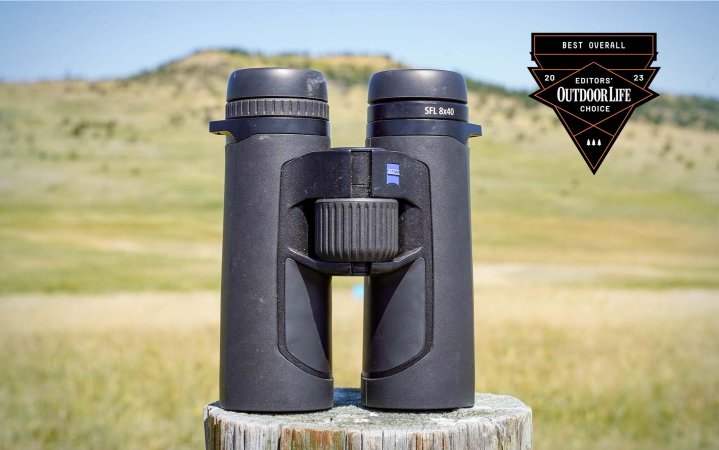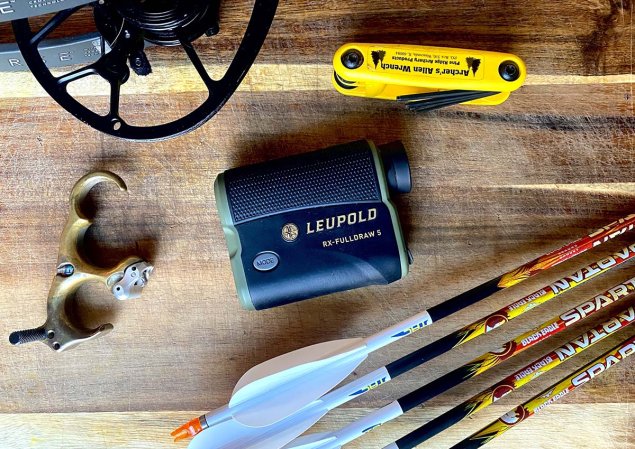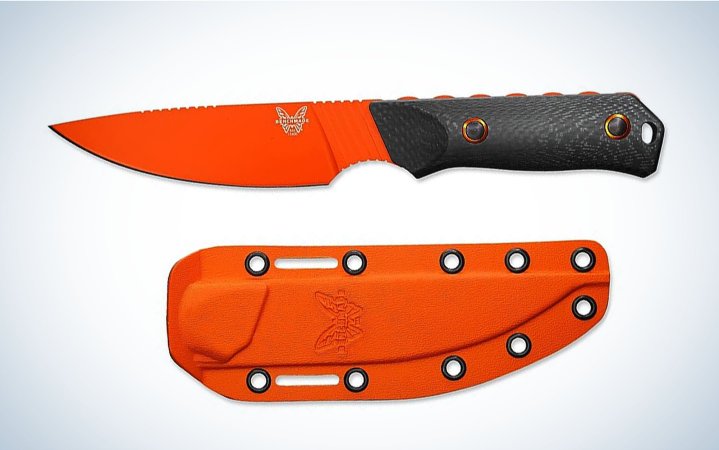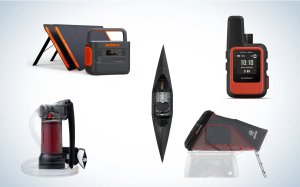We may earn revenue from the products available on this page and participate in affiliate programs. Learn More ›
One way to find out what deer hunting gear works, and what doesn’t, is to play equipment roulette. Or you could use the head-to-head tests we conducted this year to find your next treestand, trail camera, broadhead, rifle, or binocular. These reviews are a starting point for making educated purchases and reduce the chances of grabbing a lemon off the shelf. Here are our picks for the year’s best deer hunting gear based on exhaustive testing.
- Trail Camera: Tactacam Reveal X Pro
- Crossbow: Ravin R29X
- Rifle: Sako 90S Adventure
- Binocular: Zeiss SFL 8×40
- Rangefinder for Bowhunting: Leupold RX-FullDraw 5
- Two-Panel Tree Saddle: Latitude Method 2
- Treestand: Lone Wolf Custom Gear .5 “Public Land Stand”
- Mechanical Broadhead: G5 Deadmeat V2
- Knife: Benchmade Raghorn
How We Chose the Best Deer Hunting Gear
Outdoor Life editors and contributors take our gear testing as seriously as our deer hunting. We’ve put each of the products we’re recommending through rigorous testing. It starts with amassing a bunch of products in one location and then putting them through a consistent test methodology. Once all the scores are added up and groups measured, the top performers are clear. So when we say something is the best, we’re confident it’s a great piece of gear.
Best Deer Hunting Gear: Reviews and Recommendations
Trail Camera: Tactacam Reveal X-Pro 3.0
Key Features
- GPS enabled
- Works on all major cellular networks
- Internal 8GB memory (no need for SD card)
- Pre-installed SIM card
- On-demand video
- Live aiming via app
- 2-inch LCD screen
- No-glow flash
- 80-foot advertised flash range
- 5-shot photo burst mode
- 1080P Video
- No-glow IR
- 1-year warranty
- Price: $155 (plans start at $5 per month)
Pros
- Excellent photo quality and field performance
- On demand photo and video
- Automatically pairs with strongest cellular network
Cons
- Mediocre nighttime photo quality
- Delayed “on-demand” video
- Must pull videos from SD card

Tactacam’s Reveal trail camera brand is still relatively new to the market, but it has already made a significant impact with reliable cameras that capture high-quality images. This year Reveal is introducing two brand-new cameras: the Reveal Pro 3.0 and the Reveal X 3.0. The Pro version has more features (so that’s the one I field tested), but the X version comes in at a lower price point of only $125.
Just like the previous Reveal cameras we’ve tested, Pro 3.0 delivers excellent photo and video quality. It’s this combination of performance and a host of new features that made it our best overall cell cam pick. First, the new Reveal automatically connects to the strongest cellular network available. Another notable upgrade is the camera has 8 GB of onboard memory and a pre-installed SIM card. This means you don’t have to mess with SD cards, although you can choose to use a card if you like (there’s still a slot for one). With the internal SIM card, the camera will update its firmware through the cellular network. The sexiest upgrade for this camera is the addition of on-demand video. In the Reveal app you select your camera and then select “request on demand video.” The camera then records a 15-second video and sends it back to your gallery. It’s worth pointing out that it took about six minutes from the request to the time the video was viewable in the app, even with three bars of service. So this is not a real-time video feed.

During the walkthrough test the camera triggered at all ranges, day and night, but it did not produce a useful nighttime photo at 110 feet. With the no-glow feature, the Reveal Pro 3.0 has a more limited nighttime range. If long-distance nighttime photos are important to you, consider the Reveal X 3.0 camera, which has a farther flash range.

The only other ding I have against the new Reveal Pro 3.0 is that you must pull video clips from the SD card if you’re using one (this excludes on-demand videos, of course). It doesn’t send videos through the app. Read my full review of the Tactacam Reveal Pro 3.0 here. —A.R.
Read our full review of the best trail cameras to see more options.
Crossbow: Ravin R29X
Key Features
- Weight: 6.75 pounds (7.98 pounds with scope)
- Length: 29 inches
- Uncocked Width: 13.5 inches
- String Life: Two years or 400 shots
- Price: $2,050
Test Results
- Speed: 452.5 fps (402 grain arrow)
- Accuracy: 1.165 inches
- Momentum: .806 lbs-sec
Pros
- Compact
- Accurate
- Easy to shoot off hand
Cons
- Short length of pull might be uncomfortable for tall shooters

The Ravin R29X was released in 2020, and yet it’s still a dominant crossbow. It offers good speed and incredible accuracy well beyond what most would consider ethical hunting ranges. After doing our official accuracy testing at 50 yards, all three testers shot the R29X at 100 yards and our groups averaged 3.5 inches with a light crosswind. That’s not a distance we’d recommend for hunting, but it was interesting to see the bow’s capability.

At 50 yards the R29X had the smallest group average at 1.16 inches. We shot three different brands of mechanical broadheads through the R29X (SEVR, G5, and Rage) and they all grouped with field points. Ravin crossbows are consistently the most accurate we test, and we think that’s partly due to the bolts clicking onto the string. That adds some consistency over most other arrows which have a groove that rests against the string rather than snapping onto it. Of course, clicking the arrow onto the string is an added step in the loading process. Even with that added step, the R29X scored the highest in the ease of loading category. It’s very easy to crank for most adults; Ravin says it requires 12 pounds of force. We also like that the rail is open without brushes or anything getting in the way of easily loading the bolt. The internal cocking mechanism is simple to use and the only noise comes from the clicks made while releasing the firing mechanism and clicking it onto the string. Our main complaint with the firing process is that the safety is located away from the trigger guard, making it hard to reach. It also lacks a positive click when you move it into the fire position.
The R29X’s bullpup design makes it short and keeps the balance point close to your body, which aids in off-hand shooting stability. The short design is also great for maneuverability, but some will find the 13-inch length of pull a little too short for a comfortable cheek weld.

The forend has a rubberized grip for off-hand shooting, which is comfortable for balancing in your palm. The downside of the rubberized grip is that it’s not ideal for clamping into a tripod or resting on a support. A flatter and more solid foregrip would be an upgrade there. For bipod shooting, there’s a section of Picatinny rail at the forward most point of the forend and we love that it’s metal rather than plastic.
When the R29X first came out it was among the fastest crossbows available, but in 2024 you can get a bow that’s 65 fps faster. Its now considered average in speed, but it’s still plenty fast. We found arrows fired from the R29X drop 6.8 inches from 20 to 50 yards. In other words, you won’t be penalized for misjudging range by a few yards in a hunting scenario.
All the crossbow testers were asked: “If you had to take one of these bows hunting tomorrow, which would you choose?” The unanimous answer was the R29X. It does everything you want a hunting crossbow to do and its accuracy leaves no doubts when you settle the crosshairs behind a deer’s shoulder.
Read the full crossbow test to learn more.
Rifle: Sako 90S Adventure
Key Features
- Caliber: 6.5 Creedmoor (tested)
- Weight: 6 pounds, 9 ounces (measured)
- Stock: Fiberglass and carbon fiber with adjustable cheekpiece
- Barrel: 20.1 inches, 1:8 twist, 5/8-24 thread adapter
- Trigger: User adjustable from 2 pounds 1 ounce to 4 pounds 2 ounces (measured)
- Price: $2,699
Why It Made the Cut
This is about as perfect a traditional hunting rifle as you can find. It is accurate, well-balanced, and utterly reliable.
Pros
- Exceptional accuracy
- Smooth action
- Great Magazine Design
- Terrific adjustable trigger
Cons
- Would prefer it had QD cups rather than swivel studs
- Could use a recessed section of Pic rail on the forend
This rifle was the runaway consensus Editor’s Choice at this year’s rifle test. It impressed us so much that I did a video on it, describing it as a perfect hunting rifle, which isn’t an exaggeration.
By every metric that we evaluate rifles this new Sako is a winner. You can tell that the Finns who designed it have a deep understanding of what serious big-game hunters need in a rifle, and they checked all those boxes in its execution.
I did an in-depth review on the Sako 90S Adventure if you want all the details but trust me when I say that this is one of the finest all-around hunting rifles we’ve ever used.

Touches like the materials used in the stock and grip, the quality of the barrel (and the accuracy it delivered), the outstanding detachable-box magazine, the silky-smooth action, and the excellent user-adjustable trigger all add up to a big-game rifle that is destined to be a generational heirloom.
Read our full review of the best hunting rifles to learn more.
Binocular: Zeiss SFL 8×40
Score Card
- Optical Performance: Very Good
- Mechanical Performance: Excellent
- Design: Excellent
- Price/Value: Very Good
Key Features
- Double-hinge, open-barrel design
- Right-barrel diopter control
- Oversized focus wheel
- Extremely light weight
- Also available in 10×40, 8×30, and 10×30 models
Pros
- SmartFocus wheel zooms from close focus to infinity in 1.4 turns
- DoubleLink Bridge enables good barrel grip
- Premium glass and coatings
- 4.9-foot close focus
- 22.6 ounces
Cons
- At $1,500, fairly pricey binocular
- Straps and case are fairly pedestrian
Our optics test objectively measures optical resolution and low light performance, and subjectively evaluates design and value. That combination of scientific and practical testing helps us choose the best binoculars among a competitive field. This year’s winner was the Zeiss SFL.
The world of premium binoculars apparently has no upper limit. You’ll pay over $3,000 for Swarovski’s excellent NL Pure or for Leica’s stunning Noctovid. Zeiss, too, asks $3,000 for its marvelous Victory SF binocular. So to find a binocular that performs nearly on par with those flagship models for half the price is worth talking about.
Zeiss saves some money on its SFL model by importing it from Japan; most premium optics are made in Germany or Portugal. And Zeiss found some additional savings in glass by using thinner lenses than it uses in its SF line. Those thinner lenses also allow the SFL to shave nearly a half pound from the SF in the same configuration.
But the image delivered by those halfling lenses is every bit as sharp and vibrant as those of Zeiss’s other premium binoculars. The SFL easily posted the top resolution score at this year’s optics test, and testers raved about the vibrant image with rich contrast and stunning colors. It lost points on disappointing low-light performance, which was partly due to its diminutive 8×40 configuration.
But the reason the SFL is here in the top spot as a hunting binocular is its field-worthy operation. Its oversized focus wheel riffs from an extremely tight close focus of 4.9 feet out to infinity in just 1.4 rotations of the wheel. That’s a huge asset for brush hunters, who use their optics to pick apart various distances, and for Western hunters, who might pan from middle-distance cover out to far vistas in the same field of view. The focus wheel, it should be noted, moves as though it rides on ball-bearing tracks, so smooth and fluid.
The Zeiss’s name stands for SmartFocus Lightweight, and the 1.5-pound heft makes them the lightest premium binos on the market, and a wonderful companion for long hikes over difficult terrain. The balance and grip provided by the open-bridge design makes the SFL feel even lighter, and testers gave high praise for the binocular’s tapered eyecups that were extremely comfortable to use for extended periods.
That’s the real question to ask of a hunting binocular—how long do you want to spend behind it? The more and longer you use a binocular, the more game you’ll spot and the more successful you’ll be. Few other pieces of hunting gear have that outsized effect on your outcome. If the 8×40 isn’t for you, look to the SFL in 10×40, 8×30, and 10×30.
Since the test, we have kept reaching for the Zeiss any time we required a binocular, one of the surest signs that it’s an optic worth a look. And possession.—Andrew McKean
Read Next: Best Binoculars for Hunting
Best Rangefinder for Bowhunting: Leupold RX-FullDraw 5
Key Features
- 6x22mm monocular
- Customizable arrow ballistics
- Flightpath technology
- Archer’s Advantage
Pros
- Selectable reticles
- Customizable arrow dynamic inputs
- Compatible with low-velocity arrows
- 6- to 1,200-yard range
Cons
- No tripod mount
- Ballistics input process is tedious
The most precise archery-specific rangefinder on the market, the new RX-FullDraw 5 builds on the attributes of the FullDraw 4, which introduced integrated Archer’s Advantage software that allows bowhunters to shoot a range and then compensate for limbs and other obstacles that might impede their arrow. It also removes the need for a cut chart when shooting extreme angles. The angle compensation makes this a must-have rangefinder for anyone hunting sheep, mule deer, or aoudad in the cliffs. It’s also a great piece of deer hunting gear for treestand hunters.
The FullDraw 5 has a 20-yard pin solution that improves the Flightpath technology, a rain/fog mode that enables close shots, Leupold’s excellent DNA ranging engine, and new ranging software that accounts for lower arrow velocities, a feature that will appeal to traditional archers or compounders trying heavy arrows.—Andrew McKean
Read our full review of the FullDraw 5 to learn more.
Best Two-Panel Saddle: Latitude Method 2
Key Features
- Two panel, but can be worn as a single panel
- Weight: 1 pound 15 ounces
- MOLLE webbing: Single row on top panel
- Waist belt: Metal free patent-pending Oplux rope bridge
- Leg straps: Webbing strap with G-hook & retainer spring, completely removable
- Bridge type: Adjustable AmSteel
- Special features: Panel magnets, two-panel strap attachment points
- Comfort: 5
Pros
- MOLLE loops are easy to use and in a good location
- Lineman’s loops are easy to use
- Doesn’t sag with weighted dump pouches
- Bridge slides through carabiner easily
- Bridge holds all positions on the bridge loops
- Bridge length is adjustable
Cons
- Price
Tree saddles are now a mainstream piece of deer hunting gear, but the best maufacturers are still small operations and Latititude is no exception. The Latitude Method 2 is a two-panel saddle that wears like a compact single-panel saddle while you’re hiking. Once you’re ready to hunt you can deploy the second panel, which is held in place by magnets. Another unique feature is the metal free design, which cuts noise.
Panel attachment “set straps” can be added to keep the panels at a set distance if desired. The waist belt is a free-floating rope belt that slides to your desired fit. The saddle is extremely comfortable while walking, and it didn’t sag with loaded dump pouches. The leg straps are comfortable and completely removable due to the G-hook attachments and can be quickly put on at the base of the tree.
The single row of MOLLE webbing is easy to access, and the dump pouches are in a good position. The fade-away lineman’s loops running from the top panel to the bottom panel are easy to use while ascending and descending the tree. The mesh panel is breathable and utilizes two vertical webbing straps for added comfort.
The AmSteel bridge is adjustable in length, slides easily through the carabiner, and holds all positions up and down the bridge loops for perfect pitch adjustments. The only con for the Method 2 is its price, while it is an extremely comfortable saddle with numerous adjustment options. —Matthew DuShane
Read Next: Best Tree Saddles
Best Treestand: Lone Wolf Custom Gear .5 “Public Land Stand”
Score Card
- Packability Score: 5
- Noise Score: 5
- Comfort Score: 4
- Setup Time: 1 minute 58 seconds
Key Features
- Weight: 5.8 pounds
- Platform Dimensions: 23 x 16.5 inches
- Comes with robust, high-quality backpack straps
- Price: $500
Pros
- No assembly required
- Made in USA (even the backpack straps)
- Seat locks in place to support heavy loads
Cons
- Includes one cam strap buckle
I tested a lot of impressive tree stands, but the Lone Wolf Custom Gear .5 was the lightest, easiest to hang, and nearly silent during setup.
The .5 is made for mobile hunting, and it has a lot of features that make it one of the easiest to pack hang ons. The .5 was very quiet while packing or hanging it, and I especially appreciated the compact profile for sneaking through thick cover without getting hung up. I found it very easy to hang, producing the only sub-2-minute setup time of the test. The Lone Wolf Custom Gear climbing sticks securely lock into place on the stand with no rattling. When stowed into pack mode, the seat locks into the stand’s frame and doubles as a load shelf to support a backpack, extra layers, or even a quartered whitetail.
The .5 is marketed as a stand for mobile hunters, but I’m confident it’s a superior option for anyone regardless of their hunting style. Whether you want to tuck away and disappear into a cedar tree or perch comfortably in your favorite white oak, the .5 is versatile enough for a wide range of hunting styles. You can even hybrid hunt from it—saddle hunting from a tree stand. However, if you plan on running your tree saddle, I’d recommend adding a second cam strap buckle to the bottom of the post to eliminate any kickout.
The carrying straps included with the .5 hang-on tree stand were a surprise. I usually toss the backpack straps included with stands and purchase them separately, but the Lone Wolf Custom Gear straps are a rare exception. They’re thick, contoured to fit your chest and shoulders comfortably, and even include a load lifter system and sternum strap to maximize the load-carrying capacity of your stand. —Erik Barber
Read Next: Best Treestands
Best Mechanical Broadhead for Whitetails: G5 Deadmeat V2
Test Results
- Sharp Out of the Box: Yes
- Passed Edge Retention: Yes
- Passed Durability Test: Yes
- Push Force: 149.45 pounds
- Measured Wound Channel: 2.04 inches
- 40-Yard Group Average: 2 inches
Pros
- One of the largest wound channels
- One of the sharpest out of the package
- Comes with practice head
Cons
- Some users report premature blade deployment
The broadhead test measures accuracy, wound channel, and push force, which is a measurement of how much pressure is required to push a broadhead through different media. We test durability, sharpness, and edge retention. Then we talked to Aron Snyder, for his feedback from using different heads on animals.
The Deadmeat V2 is a rear-deploying mechanical, available in 100 or 125 grains. The blades are retained by a collar rather than a band. Snyder cautions that the blades can deploy when caught on brush during a stalk, which is less of an issue for treestand hunters.
In the gel test, there were only a few broadheads that recorded a wound channel over two inches, and the Deadmeat V2 was one of them. “The Deadmeat is one of the most accurate and devastating mechanicals I’ve used,” Snyder said. Our testing confirmed his in-the-field experience. Aside from the large wound channel, the Deadmeat V2 was accurate, durable, and at 220 grams it was the third sharpest. It also did the second best of all the mechanicals in the push force test, despite its large cutting diameter. The blade sharpness and tip design were contributors to its ease of penetration. Those attributes make this one of the best pieces of deer hunting gear for bowuhnters. —Scott Einsmann
Best Knife: Benchmade Raghorn
Key Features
- Blade Length: 4.125 inches
- Overall Length: 8.88 inches
- Weight without Sheath: 3.5 ounces
- Steel: CPM Cru-Wear
- Handle Material: Carbon Fiber
- Sheath: Boltaron
- Finish: Orange Cerakote
- Price: $378
Pros
- Select Edge technology made this the sharpest blade from the factory by a solid margin
- Super light for long range and high-altitude hunts
- Blaze orange sheath and blade make it hard to lose and easy to find
- Comfortable grip and nimble blade
Cons
- Expensive
- Sheath has no clip or loop, and could be a little tighter retention
The Benchmade Raghorn costs more than some entry level hunting rifles, but the cutting performance is elite. Benchmade offers Select Edge on some of its models, and this blade came with a near mirror polished edge that was whittling hair when I took it out of the box. For the harness cut test, it blew through one layer like it wasn’t there, so I sliced through a spot with four layers stitched together, and it sliced a curved cut through that section more easily than most knives went through one layer. I used the Raghorn to debone a whitetail’s front shoulder with ease. While butchering the shoulder, the grip was comfortable, and the jimping gave excellent traction.
The test group fought over who got to do the cut tests with the Raghorn because it just melted through everything. The Raghorn is ultralight, and would be the perfect companion on a backpacking hunt where weight matters. The Cru-Wear steel has very good edge retention, and since it comes so sharp, you have a long way to go before it will need a touch-up. However, because of the thin blade, this is not a camping or bushcraft knife. This is a purebred, lightweight hunting knife that’s worthy to be among the best deer hunting gear. Amazing on game for slicing hide, deboning, and butchering, but not made for heavy-duty tasks.
The only drawback for the Raghorn (other than the price) was the sheath. It comes with holes so that something like an Ulti-Clip could be mounted, and it comes with slots for mounting on Molle webbing, but there is no belt loop or clip included. For the price, I would have expected something to give you a carry option other than your pack or your kill kit. That being said, this knife will reside in my hunting pack permanently. If you are looking for the ultimate fixed blade for hunting, look no further than the Benchmade Raghorn. —Drew Conover
Read Next: Best Fixed Blade Knives
How to Choose the Best Deer Hunting Gear


The best deer hunting gear for you depends on where you live and how you hunt. While a certain stand could be ideal for hunting the Milk River it might not work in South Texas. That’s why we try to test a wide variety of gear in each of our tests. Keep in mind that while our best overall picks are all great products, they might not be the best for you.
Deer Hunting Priorities
We might disagree on the best hunting boot, but one thing we can all see eye to eye on is that deer hunting gear varies with location and hunting style. Yet, there are universal deer hunting priorities to keep in mind before clicking add to cart.
Your gear has to be:
- Quiet
- Reliable
- Weather appropriate
- Unobtrusive
If your gear doesn’t alert deer to your presence, consistently works in those clutch moments, and is unphased by weather, you have something worth adding to your system.
Final Thoughts on the Best Deer Hunting Gear
We’ve done the hard work of testing the best deer hunting gear and weeding out the duds. We recommend using this article as a starting point and diving deeper into the full reviews for each category, where you’ll find more options for your use case.
- Best Trail Camera: Tactacam Reveal X Pro
- Best Crossbow: TenPoint Flatline 460
- Best Rifle: Kimber Hunter Pro
- Best Binoculars: Zeiss SFL 8×40
- Best Scope Under $500: Meopta Optika5 2-10×42
- Best Rangefinder for Bowhunting: Leupold RX-FullDraw 5
- Best Two-Panel Tree Saddle: Latitude Method 2
- Best Treestand: Lone Wolf Custom Gear .5 “Public Land Stand”
- Best Mechanical Broadhead: G5 Deadmeat V2
- Best Knife: Benchmade Raghorn
